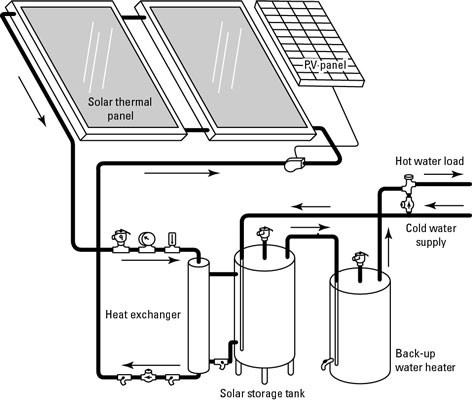Closed-loop, active, antifreeze systems are the most versatile and failsafe of all the solar supplemental water heating systems. Most new solar homes feature a variation of one kind or another.
A special water-heater tank incorporating a heat exchanger works in conjunction with one or more flat-plate, roof-mounted collectors. Glycol, or some equivalent antifreeze fluid, fills the collector and associated routing pipes. A controller measures the temperature in the collector fluid, as well as the temperature in the hot water tank. When heat's available for transfer, pumps are activated to move the collector fluid. The hot water heater tank also has a backup means for independent heating, either gas or electric.

The flat-plate collectors can be mounted in almost any configuration, at great distances from the exchanger. The closed loop is always full of fluid, so the pump pressure requirements are much easier than those for a drainback system (you don't need to worry about head pressures).
The pump can be very small, with very little head pressure, which means you can choose lower power and better efficiency. Running these types of pumps from a PV panel is practical, which increases efficiency even more. (At night, when no sunlight can power the PV panel, there's no hot water to be pumped anyway, so it's a good match.)
You can get complete kits. Installation of the parts is no more difficult than for other systems, but charging the closed-loop isn't straightforward, and doing it incorrectly can damage the system and give you inefficient performance. If you're going to do it yourself, you need to understand how to fill the closed loop with fluid (there can be no air pockets, or performance suffers).
The major limitation of these systems is the tendency of the antifreeze fluid to degrade over time. When the fluid gets really hot, it degrades quickly, resulting in inefficiency and buildup of deposits on the interior walls of the pipes and collector. For a properly maintained system, you should only need to change the antifreeze fluid every ten years. Preferably, have a qualified serviceperson inject new fluid into the system; it has to be done just right.
The best way to prevent the fluid from overheating is to make sure that the fluid in the closed-loop is circulating at all times when it's sunny out. Therefore, you can get really hot water in your domestic tank, and a tempering valve is critical. You need to use copper pipe; it's the only material that can withstand very high temperatures.
Make sure that the copper pipe is well insulated wherever children may touch it. The pipe can get extremely hot.

